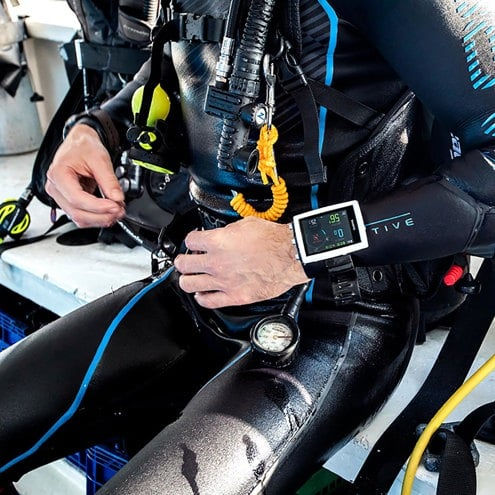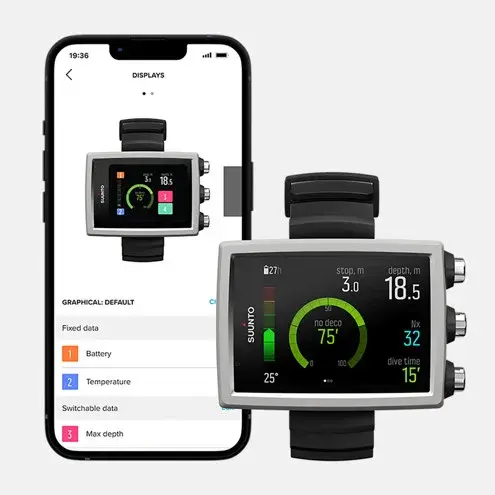Suunto EON Core Review | Feature Rich Dive Computer With Big Flaws
- Scott Finch

- Jun 13
- 6 min read
Suunto EON COre Tested in Real Dive Conditions—Why This Budget-Friendly Suunto Might Still Disappoint Serious Divers
Here we take a look at a Suunto dive computer offering. Scott got his hands on one and has been putting it through its paces in this Suunto Eon Core review.
If you’re a keen diver, you’ve probably used—or at least heard of—Suunto as a dive computer and outdoor wearables brand. And if you’re a really keen diver, you likely already have strong opinions about them. So, does this more modern model challenge any of those preconceptions?

ARE YOuU SHORT OF TIME?. Before we go any further, if you are short of time then have a quick look below:
👍 GOOD POINTS
Affordable
Feature-rich—even useful for more advanced and technical dives
Ships with both strap and bungee mounts and screen protector
Good battery life on low brightness
Supports both Suunto’s RGBM and Bühlmann ZHL-16 GF algorithms
Easy USB magnetic charging
👎 BAD POINTS
Battery life very short at full brightness
Screen brightness can appear dull underwater
Screen is prone to damage, even with included protector
Over-sensitive ascent rate add penalty time too easily
Compass is too primitive for pro navigation
Software glitches and system instability on my model
Poor after care
The Suunto EON Core: Field-Tested and Flawed
First: Yes, It’s Air Integrated (But I Didn’t Use It)
Before we dive into this Suunto Eon Core review, let me say this clearly: the Suunto EON Core does support wireless air integration via optional tank pods. If you’re into that tech, you’ll appreciate that it syncs gas pressure, tank time, and consumption data directly to your display. However—I don’t use air integration in my own diving, so I didn’t test this feature. For me, reliability and battery life matter more than another point of potential failure. But it’s there if you want it.
First Impressions: A Modern Suunto?

When I first got my hands on the Suunto EON Core, I wanted it to be good. Suunto has long been a gateway brand in diving—affordable, accessible, everywhere. But for seasoned divers, they’ve also become synonymous with conservative deco models, erratic ascent penalties, strange saftey stops and underwhelming innovation.
The EON Core looked like a departure: bright color screen, custom dive displays, Bühlmann GF support!, multi-gas handling—even CCR mode. And all of this at a lower price point than the EON Steel or newer Ocean model. On paper? Pretty promising.
Over the last few months, I’ve used this thing almost daily: volcanic walls in Gran Canaria, leading groups in the Philippines, shallow check dives, deeper gas dives, teaching, guiding. If the EON Core was going to impress—or fail—it had every chance.
What It Gets Right
Let’s start with the positives. The EON Core is packed with features, and a few of them shine.
✅ The Display (Above Water)
That 320×240 full-color screen is crisp, readable, and nicely laid out. You get multiple UI modes (prominent, graphical, classic) and can customize what’s shown on each screen. Depth, time, NDL, deco obligations—layout it your way. Suunto’s app (plus DM5) makes syncing and editing settings easy enough.
✅ Algorithms for All
Huge win: the EON Core lets you choose between Suunto’s Fused RGBM 2 (their bubble-based model, refined but still conservative) and Bühlmann ZHL-16 GF with configurable gradient factors. For many divers—especially those doing staged deco, deeper work, or just wanting transparency—this is a massive upgrade from the opaque algorithms Suunto used to lock you into.
✅ Tech Capability at Rec Prices
You get 10 gas mixes, air, nitrox, trimix, and even CCR support. That’s rare at this price point. It’s a computer you can grow into, or use as a solid backup for tech setups.
✅ Mounting and Charging
You get both a silicone strap and bungee mount in the box. The USB magnetic charger is easy to use, and if you keep screen brightness low, battery life is excellent (20+ hours logged at low brightness).
✅ Air integration
A lot cheaper air pods than the competition as well so a sure winner for the tech savvy.
✅ Good mobile App connection
The Suunto App is effective and reliable with all the infromation you would need. It’s missing the more detailed dive planning of others but this should be expected

But Then the Cracks Appear
Unfortunately, the more I used the EON Core, the more issues showed up—and some are hard to ignore.
❌ The Display (Underwater)
Yes, it’s full color. Yes, it’s big. But underwater? It’s not bright enough, especially when you apply the included screen protector (a must, since the display scratches easily being cheaper glass than a garmin or shearwater). On deeper dives in sunlight, I had to twist my wrist like I was trying to read a smartphone in direct sun and thats on the highest brightness setting, thats not good.
To make it usable, I set brightness to 100%. That’s when the battery life tanked. Suunto claims 10–20 hours in dive mode—but on max brightness, I got about 8 dives, tops, averaging 50 minutes each. That’s manageable for casual use, but on dive-intensive days or liveaboards, it’s a constraint.
❌ Battery Failure
Speaking of battery… I had a total failure one morning before guiding students. Fully charged the day before, but it just wouldn’t turn on. After a full recharge, it booted—but had lost all date and time data. That’s not “low battery”; that’s a system crash. Maybe it drained overnight from accidental activation. Maybe not. Either way—it’s a confidence killer.
❌ Overreactive Ascent Alarms
The EON Core is way too twitchy about ascent rates, especially near the surface. If it thinks you’ve come up too fast, it’ll slap on a mandatory 30-second stop—even after your safety stop is complete. This gets messy if you surface in swell, help a student, or just get nudged above 5m. The alarm screams, and the computer tells you to descend again. Not ideal in rough water, or in front of students on the boat where it will keep alarming for some time untill you go back in the water for 30 more secound
Sure, it’s conservative, and many wont mind this or could like this feature—but it’s also not smart about real-world scenarios and fro pros needs an off feature.
❌ Compass: Its not good enough
Suunto uses a 3D tilt-compensated compass. Sounds great. But in practice? Very limited for advanced navigation. No reciprocal heading on screen, no option to set one, no 90° adjust option. It gives you a heading and that’s it. And instead of a single heading marker it sets two yellow bars with a gap in the middle, no idea why they did that. Compared to the Garmin Descent series, it’s like using a compass app from 2010. Frustrating and not reliable for pro work. If you want to make a reciprical with this computer you need to turn around 180 degrees, remove the old heading and set another one, hoping you werent to far of the mark.
❌ Software Glitches
Early on, the tissue tracking (O₂/N₂) just… didn’t work. No loads, no tracking. Customer support was unhelpful—until I mentioned I was a dive profesional and before that they told me i needed to return it, just before travailing to the Philippines to lead divers. After syncing and updates, it randomly fixed itself. That’s not good enough.
Later, the dive planner froze up when I adjusted surface intervals. I stopped using it. Could be a firmware bug, could be Suunto conservatism kicking in—but it’s glitchy, and that’s a recurring theme.
Final Point
The EON Core looks like a solid all-rounder. On a good day, and for a beginner it is:
✅ Feature-rich for beginners or intermediates with options to advance
✅ Supports deco, gas switching, CCR
✅ Easy to read above water
✅ Excellent app and software integration
✅ Air Integration pod compatible
But when you actually dive with it long-term, the issues stack up:
❌ Dim, fragile screen
❌ Serious battery drain at high brightness
❌ Alarm overkill on ascent
❌ Glitchy firmware
❌ Weak compass
❌ One total battery failure
Verdict: Would I Recommend it?
Well Would I recommend the EON Core?
No. Not at this price, not with these flaws.
If you’re doing a few dives a year and love the features then maybe. But if you dive often, or depend on your computer for work, training, or tech? Look elsewhere.
The Garmin Descent G1—and now G2—offers better reliability, brighter screens, and stronger navigation. The Suunto Ocean is worth a look if you just want an attractive rec computer. But the EON Core sits in a weird middle zone, and for me, it just doesn’t deliver.
Final word to Suunto: You’re close, but not close enough. Reliability and usability still matter most.
.









Comments